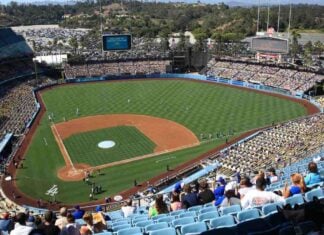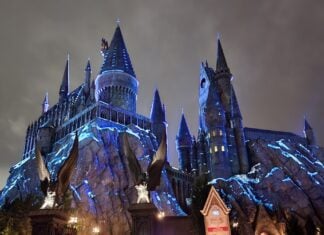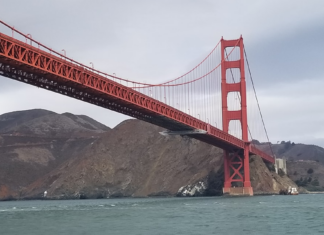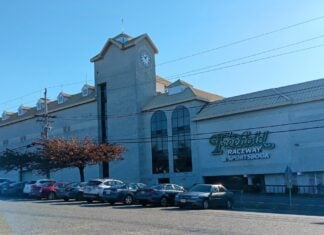
Elizabeth “Betsy” Griscom was born on New Year’s Day, 1752 on the family estate in Gloucester Towne, then the Gloucester County seat of government, along the Delaware River.
She was the eighth child of 17 born to Samuel and Rebecca Griscom and grew up in what now is Gloucester City until the family moved to Philadelphia. She learned to read, write and sew at a Quaker school, and went to work at a Philadelphia upholstery shop. She fell in love with fellow apprentice John Ross, whose father was an Episcopalian minister.
At the tender age of 21 and against the wishes of both families, Betsy and John boarded a ferry and returned to her hometown to elope. They were married at Gloucester City’s Hugg’s Tavern on the waterfront on Nov. 4, 1773.
Exactly 250 years later and on the grounds of the same tavern, their 250th wedding anniversary was celebrated with a reenactment on Nov. 4 in Proprietor’s Park. County Justice of the Peace James Bowman (played by Mayor Dayl Baile) united Betsy (Natalee Aaazri) and John Ross (Jacob Spotts) in the “holy bonds of matrimony” and pronounced them “man and wife” – to the delight of some 300 witnesses.
“I thought today’s celebration was wonderful,” said John Robert Harker, a sixth generation descendant of Ross who walked the bride up to the Betsy Ross pavilion along the aisle winding through the park.
“As a child, we knew about our connection to Betsy Ross. This reenactment of her wedding is so special to our family,” noted Harker, who traveled from Maine with his wife, Deb Parry, for the big day.
“It was a very exciting event,” said his daughter, Erin Harker Fife, who came from Concord, Massachusetts – where the first shot of the Revolutionary War was fired – with her children Zoe and William, eighth-generation descendants.
“The organizers did a spectacular job and the entire community participated,” added Fife, who praised the actors from the Gloucester City High School Drama Club.
“This has been a lot of fun,” said her brother, Jace Harker, who traveled from Maplewood with his son Zain. “Besty Ross has always been a part of the background in our family.”
Fife said it was important for her children and her nephew to be a part of the celebration. “They saw a piece of history come alive that they are connected to.”
“I think the reenactment went great,” said Joe Hargesheimer, who came up with the idea five years ago. “We had a lot of help from the Gloucester City History Celebrations Committee.”
Hargesheimer and Lisa Debus were the wedding planners, members of the committee dressed in Colonial garb as part of the bridal party, and City Clerk Vanessa Little and Ted Howarth made sure everyone had a proper seat during the wedding reception at the Elizabeth Ballroom.
“Today was fantastic,” wedding guest and former Mayor Robert Bevan offered.
“It was like ‘Back to the Future,’ and what a beautiful seating out on the waterfront.”
Betsy Ross is remembered as a dedicated patriot who created the first commissioned U.S. flag, with its 13 five-point stars and stripes representing the first 13 colonies. Yet, her support for the Continental Army also came at a great, tragic cost: Her first two husbands died during the Revolutionary War.
Betsy and John Ross started their own upholstery business in Philadelphia, and he joined the Pennsylvania militia. While guarding an ammunition cache in mid-January 1776, John was mortally wounded in an explosion, according to USHistory.org.
“Though his young wife tried to nurse him back to health, he died on the 21st and was buried in Christ Church cemetery.”
In late May or early June of 1776, according to Betsy’s telling, she had that fateful meeting with what was known as the Committee of Three – George Washington, George Ross and Robert Morris – and that led to her sewing the first flag.
Betsy married again in June 1777, this time to sea captain Joseph Ashburn in a ceremony performed at Old Swedes Church in Philadelphia. During the winter of 1777-’78, she was forced to share her home with British soldiers whose army occupied Philadelphia. Meanwhile, the Continental Army was suffering that most historic winter at Valley Forge.
Betsy and Joseph had two daughters, Zillah and Elizabeth. On a trip to the West Indies to procure war supplies for the Revolutionary cause, Capt. Ashburn was captured by the British and sent to Old Mill Prison in England, where he died in March 1782.
Betsy learned of her husband’s death from her old friend, John Claypoole, another sailor imprisoned at the brutal prison. In May of 1783, Betsy was married for the third time to Claypoole, and they had five daughters: Clarissa Sidney, Susannah, Rachel, Jane and Harriet. Clayoole died in 1817 after years of poor health.
The Harker family traces its roots to Jane Claypoole, who married Caleb Camby. Their daughter Catherine married Lloyd Balderstone. Their son Geroge married Myra Jane Atwood, whose daughter Sarah married Herbert Parker. Their son, John Balderstone Harker, married Isabella Roberts, who gave birth to John Robert Harker.
“When Joe first contacted me about the idea for the reenactment, I was uncertain,” acknowledged Harker, but he was soon on board.
As for Betsy Ross, she continued working until 1827, bringing many of her immediate family into the business with her. After retiring, she went to live with her married daughter Susannah Satterthwaite in the then-remote suburb of Abington, Pennsylvania, to the north of Philadelphia. She died on Jan. 30, 1836 at the age of 84.
And 250 years later, the thrill and wonder of her first marriage was recreated in Gloucester Towne, where the community gathered to celebrate the life of a true American patriot.









